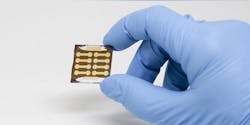More Effective, Less Expensive Solar Power on the Horizon
Two recent innovations could soon drive down the cost of solar power by making materials cheaper and more efficient.
Printable Perovskites
Printing solar cells could be as easy and affordable as printing a newspaper, according to a team from the University of Toronto. Panels would attach to virtually any surface, offering more opportunities for buildings to harness solar power.
The key is a low-temperature process in which the raw materials for perovskite solar cells are mixed into a liquid to form a kind of “solar ink” that can be printed onto glass, plastic or other materials with a simple inkjet printing process not unlike a home printer. The research team discovered a new chemical reaction that allows them to overcome previous challenges in manufacturing a high-quality electron selective layer, a crucial component of perovskite cells that extracts electrons from another layer of tiny crystals.
“The most effective materials for making electron selective layers start as a powder and have to be baked above 500 degrees C.,” explains Hairen Tan, leader of the research team. “You can’t put that on top of a sheet of flexible plastic or a fully fabricated silicon cell – it will just melt.”
The new reaction allowed the team to grow an electron selective layer made of nanoparticles in a solution directly on top of the electrode. Heat is still required but the temperature stays below 150 degrees C., which is less than the melting point of many plastics, Tan adds. The efficiency of cells made with the new method is roughly 20.1%.
Tandem Technology
Reaching for new performance records, researchers at Stanford University and Arizona State University are experimenting with stacking two PV materials – silicon and perovskite – together in a tandem solar cell. The combination converted sunlight to energy with an efficiency of 23.6%, falling just short of the 26.3% record set by the best silicon-only solar cell, according to the teams’ collaborative work published in the journal Nature Energy.
“We’re gunning for 30% with these tandem cells, and I think we could be there in two years,” says Zachary Holman, Assistant Professor of Electrical Engineering at Arizona State.
The two layers are designed to capture different wavelengths of light, with the top perovskite layer excelling at absorbing visible light and the silicon base capturing infrared light. The team is now investigating ways of preserving the delicate perovskites, such as protecting the perovskite with an indium tin oxide layer that also functions as an electrode.
